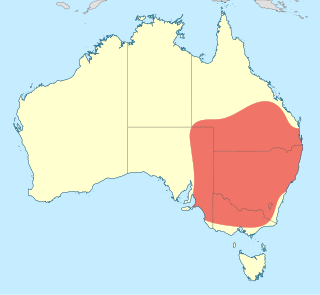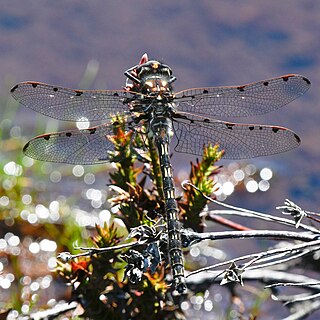
Austrogomphus amphiclitus, also known as Austrogomphus (Pleiogomphus) amphiclitus, is a species of dragonfly of the family Gomphidae, commonly known as the pale hunter. It inhabits streams and rivers in eastern Australia.

Austrogomphus prasinus, also known as Austrogomphus (Pleiogomphus) prasinus, is a species of dragonfly of the family Gomphidae, commonly known as the lemon-tipped hunter. It inhabits streams and rivers in northern Queensland, Australia.

Austrogomphus bifurcatus, also known as Austrogomphus (Pleiogomphus) bifurcatus, is a species of dragonfly of the family Gomphidae, commonly known as the dark hunter. It inhabits streams and rivers in northern Queensland, Australia.

Austrogomphus divaricatus, also known as Austrogomphus (Pleiogomphus) divaricatus, is a species of dragonfly of the family Gomphidae, commonly known as the fork hunter. It inhabits streams and rivers in northern Queensland, Australia.

Austrogomphus ochraceus, also known as Austrogomphus (Austrogomphus) ochraceus, is a species of dragonfly in the family Gomphidae, commonly known as the jade hunter. It inhabits streams, rivers and lakes in eastern Australia from north of Brisbane through New South Wales to Victoria.

Austrogomphus angelorum, also known as Austrogomphus (Austrogomphus) angelorum, is a species of dragonfly of the family Gomphidae, commonly known as the Murray River hunter. It inhabits slow-flowing parts of the Murray River in South Australia and on the border of New South Wales and Victoria.

Austrogomphus arbustorum, also known as Austrogomphus (Austrogomphus) arbustorum, is a species of very small dragonfly of the family Gomphidae, commonly known as the toothed hunter. It inhabits rivers and pools in northern Queensland, Australia.

Austrogomphus doddi, also known as Austrogomphus (Austrogomphus) doddi, is a species of dragonfly of the family Gomphidae, commonly known as the northern river hunter. It inhabits streams and rivers in north-eastern Queensland, Australia.

Austrogomphus australis, also known as Austrogomphus (Austrogomphus) australis, is a species of dragonfly of the family Gomphidae, commonly known as the inland hunter. It is widespread and common, inhabiting rivers and pools in inland eastern Australia.

Austrogomphus collaris, also known as Austrogomphus (Austrogomphus) collaris, is a species of dragonfly of the family Gomphidae, commonly known as the western inland hunter. It inhabits streams, rivers and pools in south-western Australia.

Austrogomphus mjobergi, also known as Austrogomphus (Austrogomphus) mjobergi, is a species of dragonfly of the family Gomphidae, commonly known as the pimple-headed hunter. It inhabits rivers and pools across northern Australia.

Austrogomphus pusillus, also known as Austrogomphus (Austrogomphus) pusillus, is a species of dragonfly of the family Gomphidae, commonly known as the tiny hunter. It is only known from one location, inhabiting a river in the Kimberley region, Western Australia.

Austroepigomphus praeruptus, also known as Austroepigomphus (Austroepigomphus) praeruptus, and up until recently Austrogomphus praeruptus, is a species of dragonfly in the family Gomphidae, It is known by the common name, twinspot hunter. It inhabits slow streams, rivers and ponds in eastern Australia.

Austroepigomphus gordoni, also known as Austroepigomphus (Xerogomphus) gordoni, and up until recently Austrogomphus gordoni, is a species of dragonfly of the family Gomphidae, commonly known as the western red hunter. It inhabits streams and pools in Western Australia.

Austroepigomphus turneri, also known as Austroepigomphus (Xerogomphus) turneri, and up until recently Austrogomphus turneri, is a species of dragonfly of the family Gomphidae, commonly known as the flame-tipped hunter. It inhabits both rapid and slow streams and pools across northern Australia.

Hemigomphus is a genus of dragonflies in the family Gomphidae, endemic to Australia. The species are small with black and yellow markings. They are commonly known as vicetails.

Archipetalia is a monotypic genus of Australian dragonflies in the family Austropetaliidae, The only known species of this genus is Archipetalia auriculata, known as a Tasmanian redspot.

Telephlebia is a genus of dragonflies in the family Aeshnidae, endemic to eastern Australia. Species of Telephlebia are medium to large, dark chestnut brown dragonflies with dark markings on the leading edge of their wings. They are crepuscular and fly at dusk.

Austrocnemis is a genus of damselflies belonging to the family Coenagrionidae. Species of Austrocnemis are tiny, bronze-black damselflies with long legs. They occur in New Guinea and Australia.

Austroepigomphus is a genus of dragonflies in the family Gomphidae. The species are medium-sized with black and yellow markings. Segment 9 and segment 10 of their abdomen are stretched. They are commonly known as hunters. The three species of Austroepigomphus are found on the eastern and northern areas of the Australian continent.





















